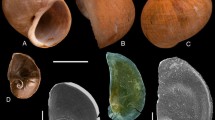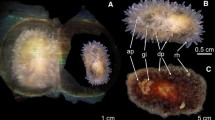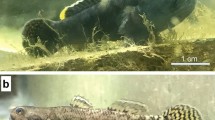Abstract
The globose moon snail Bulbus carcellesi Dell, 1990 (Naticidae), and its egg masses were collected from the Mar del Plata Submarine Canyon at depths of 201–2082 m) in August 2012 and May 2013. Embryos of this species undergo encapsulated development, and the egg capsules are the largest ever recorded for this family, 8.8–14.1 mm in diameter. The largest naticid egg capsule previously recorded was only 3 mm. Each egg capsule contains a single, 200-µm diameter egg and a considerable amount of white material (supplementary food), which allows the embryo to grow to an enormous size (up to 6.0 mm in shell diameter) before hatching as a crawling juvenile. The volume of this juvenile shell is 45 times the volume of previously reported naticid hatchlings. This great size and the number of whorls in the hatchling shell suggest a slow rate of development, akin to many other deep-sea invertebrates.






Similar content being viewed by others
References
Amio MA (1963) Comparative embryology of marine gastropods, with ecological considerations. J Shimonoseki Univ Fish 12:229–358
Ankel WE (1930) Nähreierbildung bei Natica catena (Da Costa). Zool Anz 89:129–135
Bouchet P, Warén A (1993) Revision of the Northeast Atlantic bathyal and abyssal Mesogastropoda. Boll Malacol Suppl 3:579–840
Childress JJ, Price H (1978) Growth rate of the bathypelagic crustacean Gnathophausia ingens (Mysidae: Lophogastridae). I. Dimensional growth and population structure. Mar Biol 50:47–62
Colman JG, Tyler PA (1988) Observations on the reproductive biology of the deep-sea trochid Calliotropis ottoi (Philippi). J Molluscan Stud 54:239–242
Colman JG, Tyler PA, Gage JD (1986) The reproductive biology of Colus jeffreysianus (Gastropoda: Prosobranchia) from 2200 m in the N.E. Atlantic. J Molluscan Stud 52:45–54
Dell RK (1990) Antarctic Mollusca with special reference to the fauna of the Ross Sea. Bull R Soc NZ 27:1–311
Giese AC, Kanatani H (1987) Maturation and spawning. In: Giese AC, Pearse JS, Pearse VB (eds) Reproduction of marine invertebrates. Blackwell Scientific Publication and The Boxwood Press, California, pp 252–313
Giglioli MEC (1955) The egg masses of the Naticidae (Gastropoda). J Fish Res Board Can 12:287–327
Gohar HAF, Eisawy AM (1967) The egg masses of four taenioglossan prosobranchs from the Red Sea. Publ Mar Biol Stn Al-Ghardaqa 14:109–147
Hain S (1990) Die beschalten benthischen mollusken (Gastropoda und Bivalvia) des Weddellmeeres, Antarktis. Ber Polarforsch 70:1–181
Hertling H (1932) Zur kenntnis des laichbandes und der veligerlarven von Natica pulchella. Zool Anz 100:95–100
Huelsken TC, Marek S, Schreiber S, Schmidt I, Hollman M (2008) The Naticidae (Mollusca: Gastropoda) of Giglio Island (Tuscany, Italy): shell characters, live animals, and a molecular analysis of egg masses. Zootaxa 1770:1–40
Lebour MV (1936) Notes on the eggs and larvae of some Plymouth prosobranchs. J Mar Biol Assoc UK 20:547–566
Murray FV (1966) A brief account of the spawn of Conuber incei (Philippi, 1853) (Gastropoda: Naticidae). J Malacol Soc Aust 1:49–52
Natarajan AV (1957) Studies on the egg masses and larval development of some prosobranchs from the Gulf of Mannar and the Palk Bay. Proc Indian Acad Sci 46:170–228
Pastorino G (2005) Recent Naticidae (Mollusca: Gastropoda) from the Patagonian coast. The Veliger 47:225–258
Pastorino G, Averbuj A, Penchaszadeh PE (2009) On the egg masses; eggs and embryos of Notocochlis isabelleana (d’Orbigny, 1840) (Gastropoda: Naticidae) from Northern Patagonia. Malacologia 51:395–402
Rex MA, Van Ummersen CA, Turner RD (1979) Reproductive pattern in the abyssal snail Benthonella tenella (Jeffreys). In: Stancyk SE (ed) Reproductive ecology of marine invertebrates. University of South Carolina Press, South Carolina, pp 173–188
Robison B, Seibel B, Drazen J (2014) Deep-sea octopus (Graneledone boreopacifica) conducts the longest-known egg-brooding period of any animal. PLoS ONE 9:e103437
Rokop FJ (1974) Reproductive patterns in the deep-sea benthos. Science 186:743–745
Thorson G (1935) Studies on the egg-capsules and development of Arctic marine prosobranchs. Medd Grønl 100:1–71
Thorson G (1936) The larval development, growth, and metabolisim of Arctic marine bottom invertebrates compared with those of other seas. Medd Grønl 100:1–155
Thorson G (1940) Studies on the egg masses and larval development of Gastropoda from the Iranian Gulf. Danish Sci Invest Iran 2:159–238
Thorson G (1946) Reproduction and larval development of Danish marine bottom invertebrates, with special reference to the planktonic larvae in the sound (Øresund). Medd Dan Fisk Havunders (Ser Plankton) 4:1–523
Torigoe K, Inaba A (2011) Revision on the classification of recent Naticidae. Bull Nishinomiya Shell Mus 7:1–133
Tyler PA, Young CM (1992) Reproduction in marine invertebrates in “stable” environments: the deep sea model. Invertebr Reprod Dev 22:185–192
Acknowledgments
We would like to thank Ricardo Farias for his help with the figures, Valeria Teso for helping us with the early sorting of the material and the people involved in the expeditions Talud Continental. We thank Fabian Tricarico for the assistance with the SEM, and finally Gregorio Bigatti and Andres Averbuj for reviewing the manuscript, Alan Kabat and an undisclosed expert who highly improved the manuscript. This work was funded by PICT 2013-2504 from Agencia Nacional de Promoción Científica y Tecnológica, and PIP 0253 from Consejo Nacional de Investigaciones Cientifícas y Técnicas. P.P., M.M. and G.P. acknowledge funding by the Consejo Nacional de Investigaciones Científicas y Técnicas (CONICET) of Argentina, to which they belong as members of the Carrera del Investigador Científico y Técnico.
Author information
Authors and Affiliations
Corresponding author
Ethics declarations
Conflict of interest
Pablo E. Penchaszadeh, Melina Atencio, Mariano I. Martinez and Guido Pastorino declare that they have no conflict of interest.
Ethical approval
All applicable international, national, and/or institutional guidelines for the care and use of animals were followed.
Additional information
Responsible Editor: J. Grassle.
Reviewed by A. Kabat and an undisclosed expert.
Rights and permissions
About this article
Cite this article
Penchaszadeh, P.E., Atencio, M., Martinez, M.I. et al. Giant egg capsules and hatchlings in a deep-sea moon snail (Naticidae) from a southwestern Atlantic Canyon. Mar Biol 163, 209 (2016). https://doi.org/10.1007/s00227-016-2990-z
Received:
Accepted:
Published:
DOI: https://doi.org/10.1007/s00227-016-2990-z




